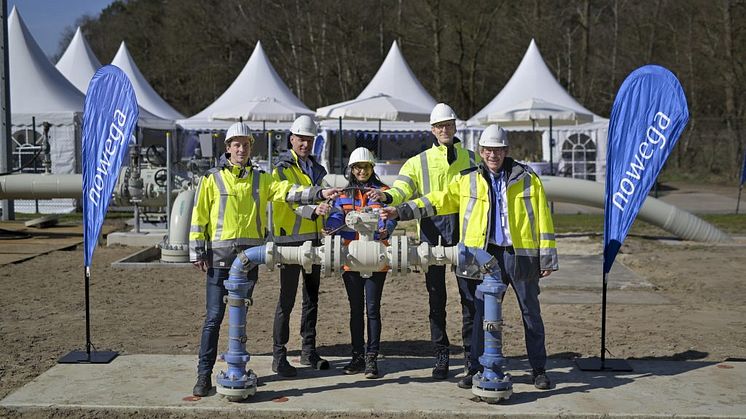
News -
Nowega Puts First Section of Its Hydrogen Grid into Operation
With 55 kilometers of hydrogen pipelines, transmission system operator Nowega GmbH has launched the first section of its hydrogen grid. In Nordhorn, the initial filling of the pipeline between Lingen and Bad Bentheim with hydrogen has begun. This section in southwest Lower Saxony is part of the core hydrogen grid and consists of 95 percent repurposed existing pipelines now converted to carry hydrogen. As part of the GET H2 network, the pipeline conversion is supported by funding from the German federal government and the state of Lower Saxony under the IPCEI (Important Projects of Common European Interest) program.
“A sustainable hydrogen economy can only succeed if we convert and build the necessary pipelines on the ground in line with the hydrogen core network,” said Frank Doods, State Secretary at the Lower Saxony Ministry for Economic Affairs, Transport, Building and Digitalization, at the event. “Today is a special day for the hydrogen ramp-up in Lower Saxony and especially for Nowega GmbH, which is taking a significant step toward the future with this project. This shows: we are making progress.”
The section of the network from Lingen to Bad Bentheim creates important connection opportunities for producers and users of climate-friendly hydrogen. “With this commissioning, we are providing the first transport capacities for the early phase of the hydrogen economy,” said Nowega Managing Director Frank Heunemann. “Focusing on the use of existing infrastructure demonstrates how we can implement hydrogen transport in a cost-efficient and timely manner.”
In the initial phase of commissioning, the network section is being filled with a total of 28,500 cubic meters of hydrogen to bring it to a pressure level of 3 bar. “This was an outstanding achievement by the entire project team. We are now performing the initial filling of the system with hydrogen and expect to have it operational by mid-April. Once the system is brought up to operating pressure, we can start the first transports,” explained Dennis Hoeveler, Head of Technical Operations at Nowega. The initial filling is carried out using hydrogen delivered by trailer.
The central first customer of Nowega’s hydrogen grid is the 300 MW electrolysis plant of RWE Generation in Lingen, which is set to begin producing green hydrogen from renewable electricity later this year. “The filling of Nowega’s first grid section is excellent news for RWE,” said Sopna Sury, COO Hydrogen at RWE Generation. “It marks a concrete step forward in building the German hydrogen core network. At the same time, the connection between our electrolysis site in Lingen and the RWE hydrogen storage facility in Gronau-Epe is becoming tangible. This link is essential for reliably supplying our customers, such as TotalEnergies in Leuna.”
In the second half of the year, the network is expected to expand further south. By then, ongoing construction work on the joint pipeline of Essen-based transmission system operator OGE and Nowega between Bad Bentheim and Legden in the Münsterland region is set to be completed. Additional connections branch off from this pipeline, including a link to the hydrogen storage facility in Epe, an existing pipeline to the Marl chemical park, and pipelines to connect industrial consumers and the import route from the Netherlands. “We are very pleased that the construction work on the pipeline between Bad Bentheim and Legden is largely completed. Moreover, the planning approval decision for the Heek-Epe pipeline was recently issued, and construction has started on schedule. This new hydrogen pipeline will link the aforementioned pipeline system to the hydrogen storage facility in Epe,” said Detlef Brüggemeyer, CTO at OGE.
“The commissioning of the first sections of the hydrogen core network provides companies that want to produce or use hydrogen with the confidence that transport will be possible in a timely manner,” said Frank Heunemann. He emphasized the importance of continued support from the new federal government for the hydrogen ramp-up. The key steps: reducing the cost of producing climate-friendly hydrogen and creating incentives for its use. This would enable the economically viable use of hydrogen as a decarbonization option for industry.
